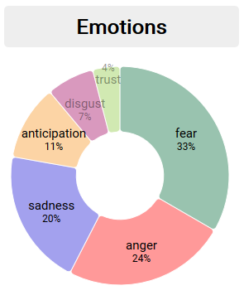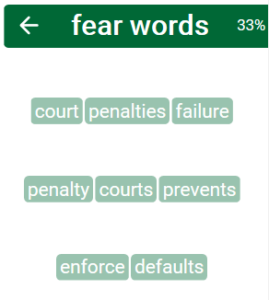Emotions are a big part of who we are as human beings. Research shows that we experience at least one emotion 90 percent of the time. Which is why emotional content performs nearly twice as well as purely factual content. It’s important for anyone that creates content to understand the role emotion plays in helping the reader experience what you mean, and be able to intentionally craft content that has emotional appeal.
What is emotive language?
The secret is out. Many brands already know that emotional appeal has positive effects on long-term ROI. Emotional marketing uses language with emotional appeal to get customers to like, remember, buy, or share their message, products, or services. Emotive language motivates consumers to respond, usually by focusing on generating a single emotion. Despite the fact that humans are complex emotional beings, brands usually target either happiness, sadness, anger, or fear.
For marketers, emotional marketing needs to balance the fine line between manufacturing “fake” feelings or keyword stuffing emotive words, and using emotive language to help their audience feel understood. Which is why your content creation and editorial process needs to include an analysis of emotive language.
If you’re not sure where to start, let’s delve further into how to analyze your content for emotive language, and what to do with that information when you have it.
1. Be specific about your intentions
If you’re trying to generate a general feeling of “happiness” in your target audience, you can still do more to make your emotional content differ from your competitors. It might be true that positive feeling words get more likes, and help raise brand awareness. However, it helps to be aware of just how many words describe “positive” feelings rather than fixating on emotive words associated with happiness.
Depending on your product, target audience, and even your industry, you might be better off using emotive language that fosters a sense of trust, reliability, or even excitement.
Effective use of language defines precisely the feeling you’re aiming to elicit – often before you start writing. That’s the first step to writing compelling content that effectively communicates your message. We challenge you to go beyond “happiness” and find the emotions that suit your corporate identity and brand style. For some inspiration, this list of emotion words is a great place to start learning how certain words connect to feelings, some of which you wouldn’t expect!
As you go through this list of words, you might want to jot down a few that stand out to you to keep an eye out for when you review and create new content.
2. Review your current use of emotive language
A great place to start is taking a few content pieces you’ve already published and review them to see if they match your intentions. If you’re not using an application or emotional analysis tool, you can do this manually by highlighting a few words you think elicit a response, and then look them up in the NRC Emotion Lexicon to find their associated feelings.
Are you using some words that elicit fear or anger, and others that build trust? That might be sending mixed messages to your reader, so it’s better to use emotive language that’s consistent with the emotional response you want.
Example: Let’s analyze a sample text from an anonymous source in the legal sector, to see how it uses emotive language. While you’re reading, ask yourself:
- What is the purpose of this communication?
- How do I feel while reading this text?
- Does the emotion match the purpose?
In its resolution from April, the Supreme Court concluded that contractual penalties don’t apply when one party rescinds a contract because of another party’s failure.
The court’s decision prevents penalties for a contractor who rescinds a construction contract because of the other party’s failure.
This issue has raised questions among scholars, commentators, and courts. Some courts, including the Supreme Court, claim that contractual penalties might be possible in such circumstances. In its most recent decision, the expanded bench of the Supreme Court explicitly supported this view.
Therefore an agreement may effectively allow a penalty payable to an investor when the investor rescinds due to a contractor’s failure to perform its non-financial obligations. However, the contractor may not enforce a contractual penalty from the investor if the contractor rescinds when the investor defaults. Similarly, the provisions of the lease imposing on a tenant a contractual penalty in the event the landlord terminates the lease agreement will be unenforceable.
| Purpose | Response |
| The purpose of this text is to notify the reader of a new challenge, of which the law firm is capable of helping its clients. Ideally, this article would present the necessary information, in a way that builds trust between the client and the firm.
This firm ideally wants to demonstrate their expertise, and reassure their clients that they can help them navigate the changes. |
Aside from a general lack of clarity, the text mostly evokes fear. Using an AI emotional analysis tool reveals that 33% of the words are fear based. Those words include penalty, court, failure, prevents, enforce, and default. A further 19% generate anger, and 14% may trigger sadness.
Unfortunately, without emotional analysis, you risk misalignment between the emotion you evoke, and the message you want to deliver. |
When you’ve got a benchmark of your emotive language, you can start intentionally writing content with a stronger emotional appeal. Different content types will likely have different purposes, so you might want to jot down the different emotions you want to elicit from different communication channels and content types.
3. Create new content with compelling emotive language
Let’s talk about feelings! When you’re creating new content, don’t be afraid to be real. It’s important to find that balance between emotional marketing and authenticity. It’s okay to trigger more than one feeling, just make sure you’re choosing emotional words that may conflict with each other intentionally.
Why would you want to do that? Let’s consider a piece of legal content, intentionally created with emotive language. Perhaps you’d like to inform your reader about new regulations or penalties, which might evoke fear. But, if you contrast that information with words associated with trust, you can later convey your expertise and reassure the reader that your firm still has their best interests in mind.
Because emotions exist on a spectrum, like colors, you can learn to write emotive content that sounds genuine, by using different “shades” of the same emotion. Robert Plutchik’s “wheel of emotions” is a great visual to show the spectrum of emotions you can choose to evoke. Combined with the list of emotive words in the last paragraph, you can start to get an idea of the different emotive words that belong to the same emotion category.
4. Measure the effectiveness of your emotional marketing
To measure the effectiveness of your emotional content, it might be helpful to document the actions you’d like your audience to take when they interact with a particular type of content. Correlating a desired action with an emotional response is the first step to generating KPIs to measure the improvement of your emotional marketing.
That way, if you see a boost in activity around the sharing, engagement, conversion, or loyalty from your customers, you’ll be able to decipher which emotions work best and how they manifest as action. Actions correlate to your business goals, and ideally, you want your emotional content to bring you closer to reaching them.
Emotion analysis shouldn’t be a one time event, but if you’re relying on a manual review process, it’s unlikely you’ll regularly assess your content for emotional appeal. For the best results in emotional marketing, you need to incorporate emotion analysis into your content governance strategy.
Ideally, before you publish your content, you would do well to run it through an emotion analysis tool that does the hard work for you. Some AI applications make it possible to correlate the words you’ve used to positive or negative feelings. When you have that information, you can then make decisions about the emotional words you want to include more of, and rephrase sentences that don’t align with your goals.
Introducing Emotional Analysis with Acrolinx
Using data crowdsourced by the National Research Council Canada (NRC), Acrolinx has developed an app to check which words in your text correlate to certain emotions. Emolinx is a new app in the Acrolinx Sidebar that analyzes the emotional qualities of your content, so you can see how well your text aligns with your intended audience response. You’ll see this feedback in two ways. One will show you the percentage of words associated with a particular feeling, and you can click on an emotion in the chart to see the list of words. You’ll also see a semantic word cloud, that shows you how often certain words appear in your content, and if they carry a positive, negative or neutral connotation.
The impact of deliberately using words to motivate consumers, based on feeling, is huge for large companies. There’s significant research to show that in a world that offers unlimited choices, emotions help people to make optimal decisions without becoming overwhelmed. Used responsibly, emotive language can make you stand out, attract, and cultivate loyal customers.
To learn more about Emolinx and how to start using it with Acrolinx, contact us today at support@acrolinx.com.
For more information on emotive language, check out our new mini guide, Writing with Feeling: A Guide to Emotive Language for More Effective Content.



